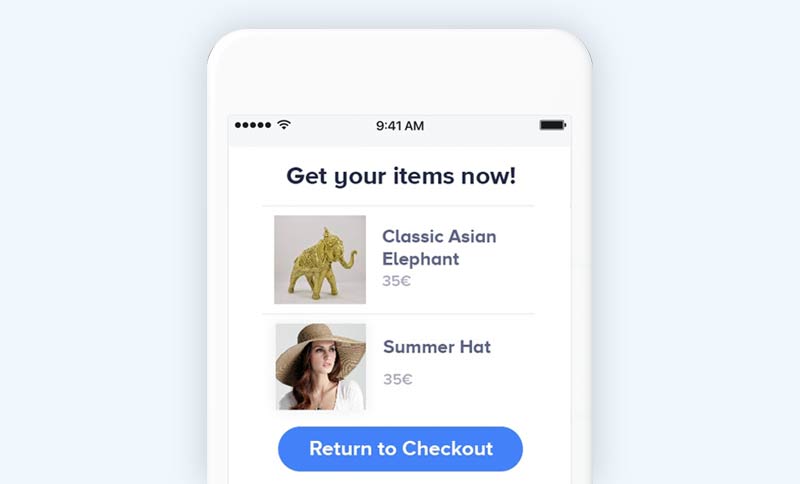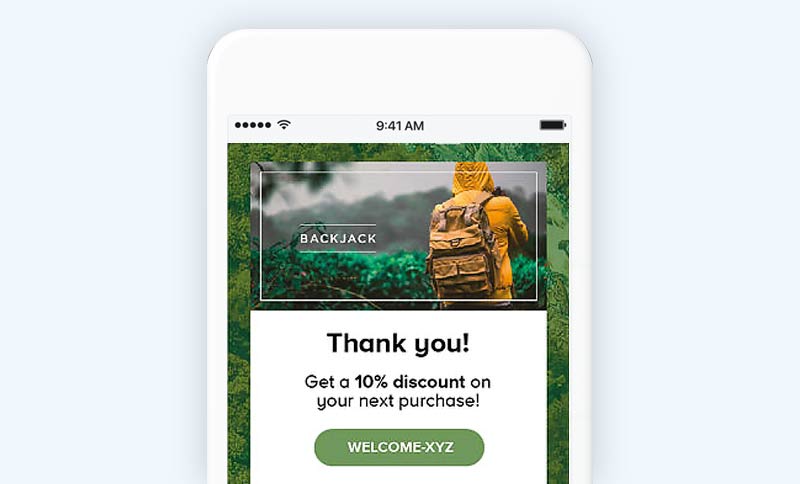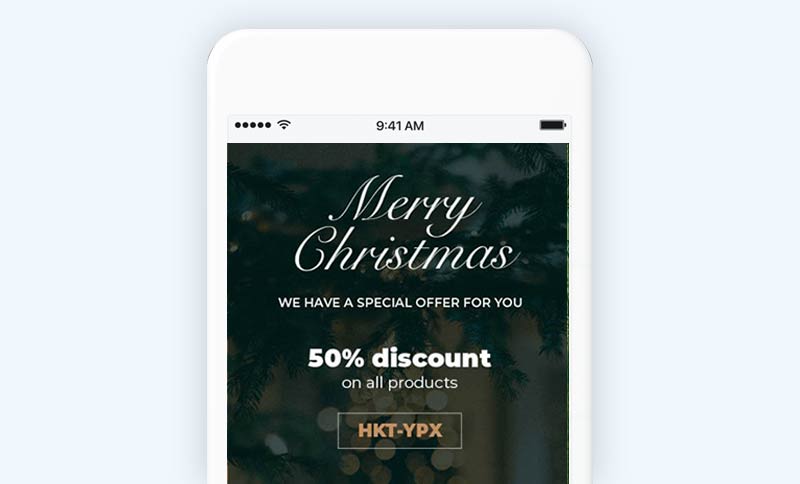
Email marketing is an excellent way for e-merchants to reach their customers with engaging, beautifully designed content that drives ecommerce profits. Convert more sales with browse-abandonment emails, retain customers long-term with win-back emails, or up-sell existing customers with post-purchase emails.
Email gives marketers a large area to fill with personalized content, company logos, product images, discount codes, etc. It presents marketers with the opportunity to get creative with design elements to convey their brand’s visual identity and showcase their items.
For marketers just getting started with email or looking for some extra inspiration, here are our top 13 email marketing campaign examples for e-commerce.
1. Welcome email
Start cultivating a relationship with new customers right from the first purchase and show you’re a personable company. Send a quick email to welcome new customers to your store and thank them for their business. A welcome email is the first step towards building brand loyalty and is a great way to start a dialogue with new customers.
When creating a welcome email, remember:
- Visuals matter - this is the first piece of messaging your new customers will receive, time to wow them. Make sure the color scheme, fonts, and layout go hand-in-hand with your website. Allow new customers to format a mental image of your brand and what you represent.
- Show you care - online shopping has the potential to go wrong, and consumers are understandably wary. Reassure customers that your brand resolves all too common e-commerce issues like incorrect sizing or damaged goods quickly and simply.
- Open up a dialogue - give customers a direct contact method right from the outset. Provide a reply-to email address, give customers links to social media sites, and actively invite customers to ask questions or give feedback about your products or website.
2. Browse abandonment email
A browse abandonment email is the best way to regain the attention of lost customers and bring them back to complete a purchase.
Automatically schedule a browse abandonment email to send the moment a potential customer leaves your site without making a purchase or placing an item in their cart.
As opposed to a cart abandonment email, a browse abandonment email won’t have a specific product to direct the customer toward. Instead, include recommendations for the most popular products sold in the last 30 days. This will maximize the chances of the potential customer loving the recommended items.
You can also include:
- An explanation of your brand’s story, key values, and what you bring customers
- Visuals that nicely match your website and overall brand image
- Information about new products, special events, or upcoming sales
3. Abandoned cart email
Similar to a browse abandonment email - cart recovery emails work to bring back lost customers and increase sales. The primary difference between the two is that the customer didn’t just browse and leave; they put an item in their cart. A marketing automation software will catalog this item, allowing e-merchants to retarget the potential customer with the exact product they considered purchasing, along with similar and complementary products.
Abandoned cart campaigns are exceptionally time-sensitive. E-merchants need to reach out immediately after the visitor exits the page as they may be looking at similar products on competitors’ sites.
Because of this urgency, abandoned cart emails work perfectly in combination with other messaging channels, such as SMS or Funnels. Each of these channels boast of a higher open-rate and faster open-time than email, and grab the attention of the customer immediately.

4. Order confirmation email
Online shopping is risky for customers. They complete their end of the bargain immediately then trust the vendor to send the right product to the correct address, quickly and undamaged. Regardless of the shipping method, there’s always lag between making the purchase and receiving the item, so reassure customers throughout the process.
The best way to make customers confident in their purchase is to follow up immediately with an order confirmation email. An order confirmation email should include:
- An order confirmation number - so that both the customer and vendor can quickly identify the order if there is an issue
- A breakdown of the purchase - including product(s), sizing of items, delivery address, and payment method
- Delivery information - inform the customer that they will soon receive a shipping confirmation message complete with tracking information
5. Payment failed email
There’s nothing more frustrating to an e-merchant than losing a customer to payment failure. Not only has the customer identified a product they want, but they have also decided it’s worth their money and they want to buy it.
A payment failed email needs to reach the customer while their intent to buy is still high, so time is of the essence. E-merchants must reach out immediately to alert the customer of the issue and offer alternative payment options to finalize the purchase.
A payment failed email should include:
- An explanation of the problem with the initial attempted payment
- A link that takes the customer right back to the shopping cart with all the contact and shipping details saved from the first purchase attempt
- Alternative payment options through sites such as Paypal or Klarna, the ability to split the payment into installments, or the option to use a different credit card
- Images of the product(s) in question to remind the customer how great they are
- Text to instill a sense of urgency, for example, ‘quick, only 2 left in stock’
6. Shipping confirmation email
As mentioned earlier, a shipping confirmation email reassures the customer that their order is on track and that they will receive their package soon.
The most important thing to include in a shipping confirmation email is a tracking number. This allows your customers to keep an eye on their package, know where it is at all times, and have a better gauge on when it will arrive.
Make sure the package tracking number links directly to the courier’s website so that in just one click your customers can see exactly where their package is.
7. Post-purchase email
Touch base and make sure customers are enjoying their new items with a post-purchase email. A post-purchase email is a great way to nurture customers, increase brand loyalty, and secure repeat purchasing well into the future.
Within the post-purchase email, ask happy customers for reviews or testimonials to give your brand social proof. Go one step further and suggest customers share images of their new items across social media for a small discount on their next purchase.
Key points to remember when sending a post-purchase email are:
- Send the email a couple of days after the expected delivery date to ensure that the customer receives the package before the post-purchase email
- Offer a small discount or free shipping to encourage customers to write testimonials or reviews
- Up-sell with recommendations for products that would perfectly complement their recent purchase

8. Newsletter email
Maintain customer relationships and keep your brand front-of-mind with a regular newsletter email. An e-commerce newsletter should reach the widest possible audience, so create a contact list that includes current customers, past customers, and future prospects.
When designing a newsletter, visuals are paramount. Make sure the images, color scheme, and font all perfectly align with existing brand imagery. Newsletters present an excellent opportunity to showcase visually exciting new products, so carefully select a few that will appeal to the broadest audience.
Some significant sections to include in your newsletter are:
- Company news - take the opportunity to broadcast any exciting developments or positive press received over the past month
- New products - showcase any exciting new products with direct links so that recipients can click to purchase
- Upcoming events - inform contacts about any events your brand is either hosting or attending over coming months
9. Holiday email
E-merchants spend the whole year looking forward to the spike in sales that comes with the holiday season. But with such a huge potential for profits, the level of competition is higher than ever.
Stand out against the competition and drive holiday shoppers to purchase with a series of festive holiday marketing emails. Within these emails e-merchants can; alert customers to any special holiday deals, highlight upcoming new products, or recommend products that will make great gifts for friends and family.
Every holiday is an opportunity for e-commerce marketing, so pre-plan campaigns around as many as you can. Holiday marketing campaigns are the most effective when they start at least two months before the holiday in question, so get organized well in advance. The most profitable holidays every e-merchant needs to include in their annual marketing calendar are:
- Christmas
- New Years
- Black Friday
- Cyber Monday
- Mothers Day
- Fathers Day
- Easter
- Valentine’s Day

10. End-of-season sale email
Broadcast special deals, discounts, and clearance items to your entire contacts list with an end-of-season sale email.
An end-of-season sale email should include:
- A selection of your most impressive sale items - select the items that have sold best in the past or are receiving the biggest discounts
- A button that takes customers directly to the sale section
- A special discount code for VIP customers to use to enhance their discounts
- A sneak-peak of next season’s products
11. Product release email
Following on perfectly from the email above, product release emails are a must every time a new range drops. Send an email to an all-contacts list showcasing exciting new items and directing recipients straight to make a purchase.
Customers love to purchase brand-new products before anyone else, so use wording throughout the email that conveys how exclusive and special these items are. Your product release email should include:
- A selection of exciting new products
- A button that takes customers directly to your website
To spread the word about your new products beyond existing contacts, ask recipients to share their new purchases on social media to receive free shipping or a special discount.
12. VIP email
You cannot understand the value of loyal repeat customers. E-merchants need to engage with repeat customers, nurture them, and build long-lasting brand loyalty. Show appreciation for these loyal customers and to retain their business well into the future with an exclusive VIP program.
The first thing brands need to do is create a list of VIP customers. There are many properties that can define a VIP customer:
- Someone who has spent more than $X amount total
- Someone who has made more than X purchases
- Someone whose average purchase amount is more than X
The relevant property range used to divide a contact list between VIP and non-VIP customers will be different for every e-commerce store. Consider average purchasing data then use that to define the metric that makes sense.
Once you have your VIP customer list, send them an exclusive VIP email. This email should include:
- Special VIP discount codes
- An offer for free shipping on the next purchase
- Sneak-peeks at high-end products coming soon
- Recommendations for some top-quality products the VIP’s will love
13. Customer win-back email
The success rate of selling to a customer who’s purchased from a site is 60-70% while the success rate of selling to a new customer is only 5-20%. Make the most of all existing customers and convert one-time customers into repeat purchasers with a customer win-back email.
If a customer hasn’t purchased from you in a certain amount of time, send them an email to tell them you miss them and showcase any exciting new products on offer.
Competition within the e-commerce sector is fierce, and with so many options available customers often forget about a brand. Sometimes all it takes is a quick reminder to regain business.
If not, there are a few extra things to include in a customer win-back email to guarantee success:
- Personalized content that lets the customer know they’re missed and that your brand hasn’t forgotten about them
- A special discount code to use on their next purchase
- Free shipping to use on their next purchase
- Images of exciting new products that customers can purchase with their special discount



